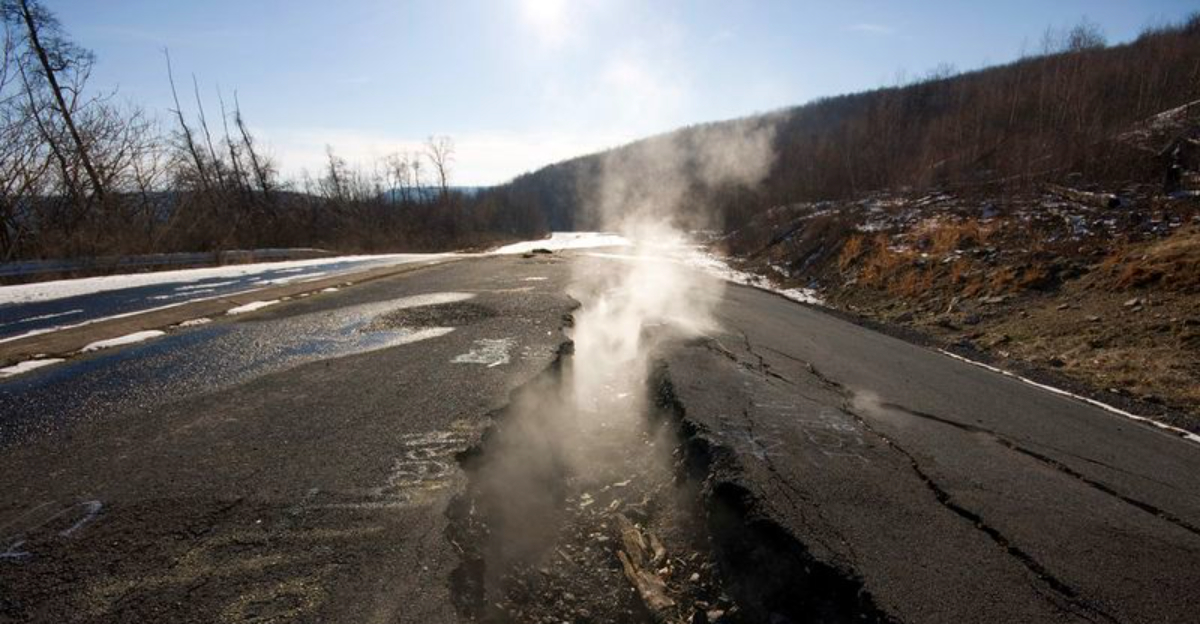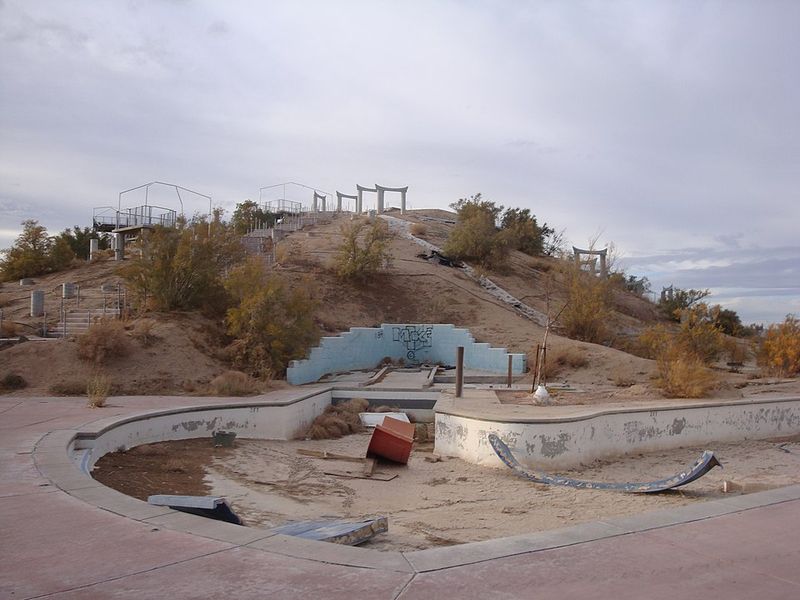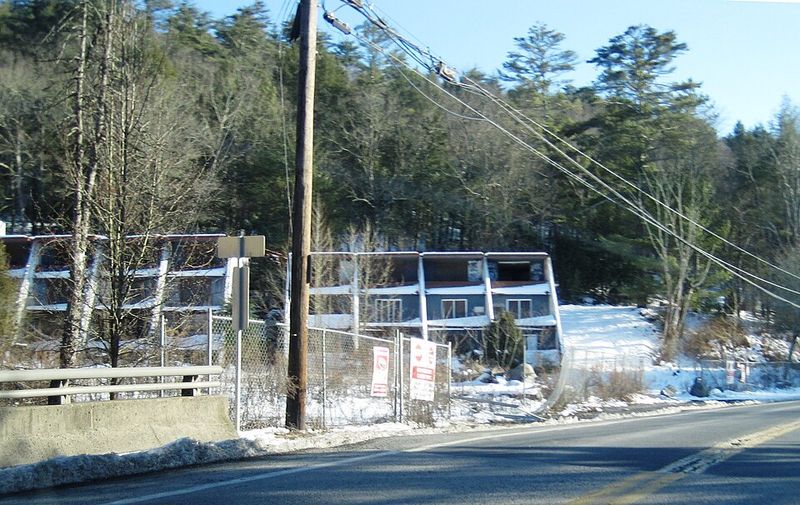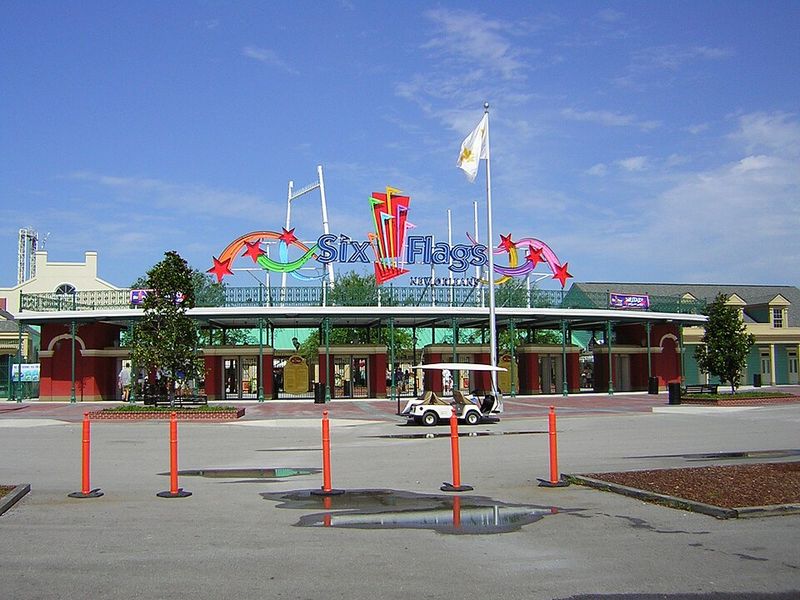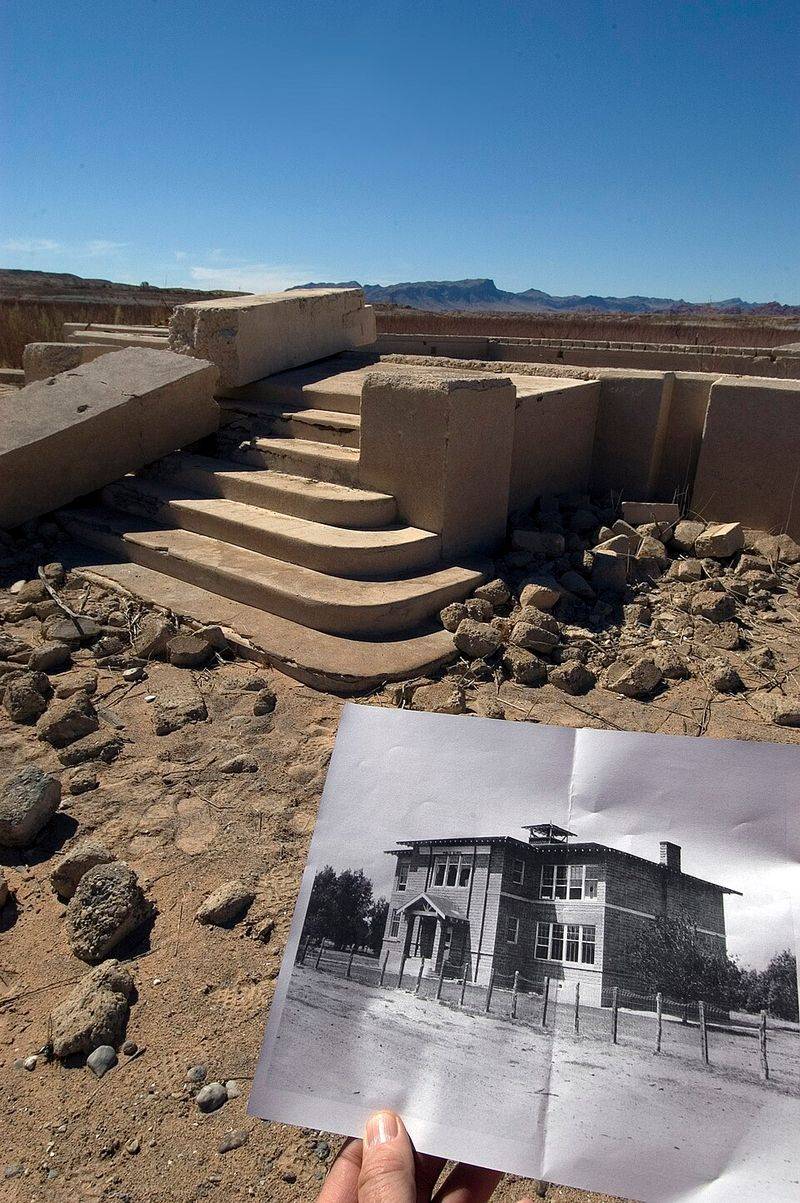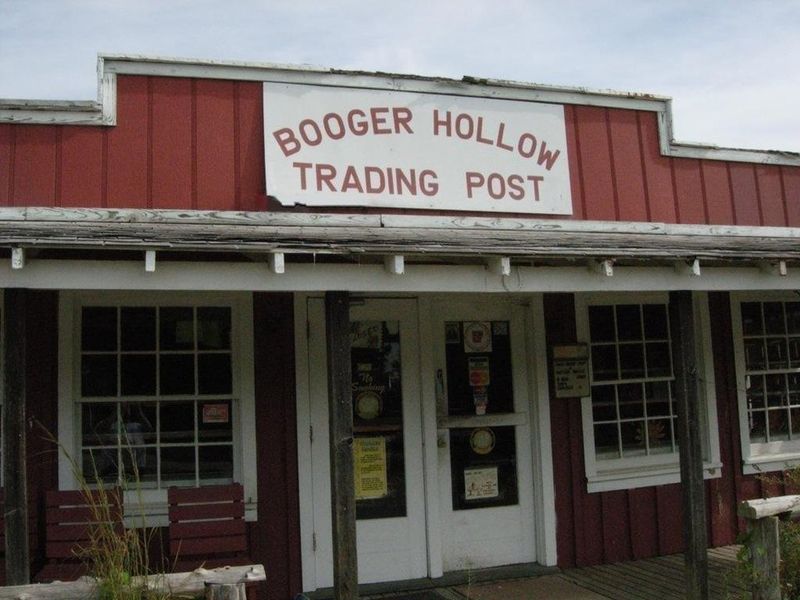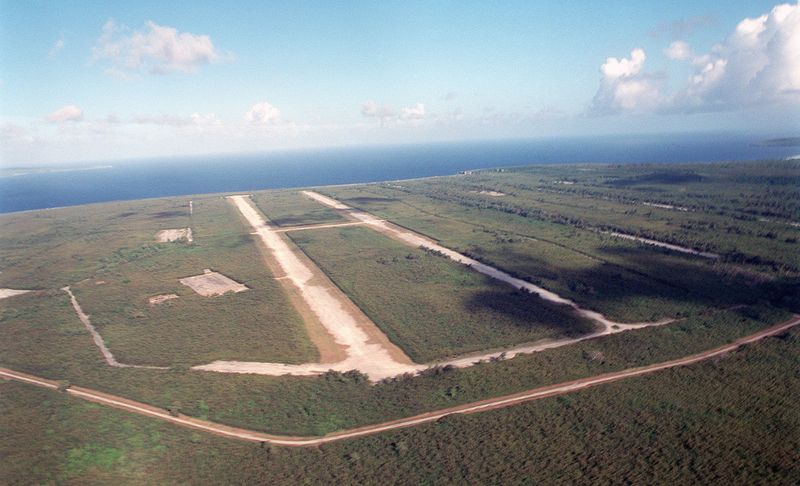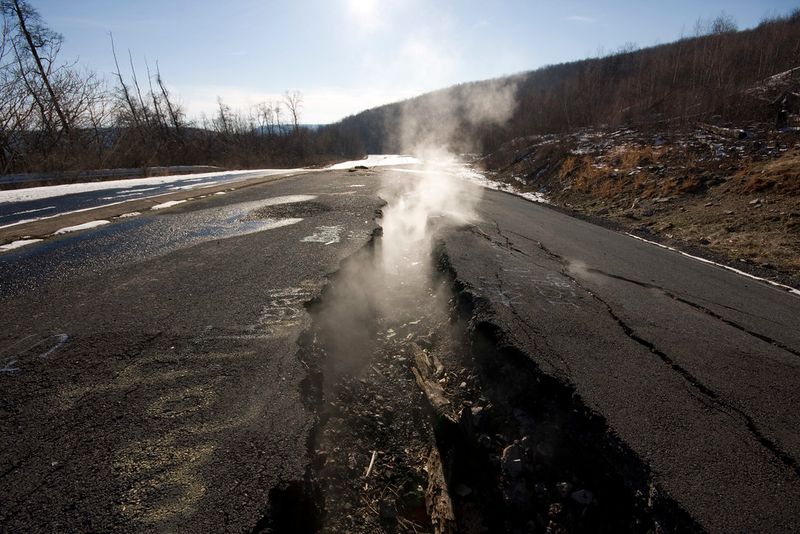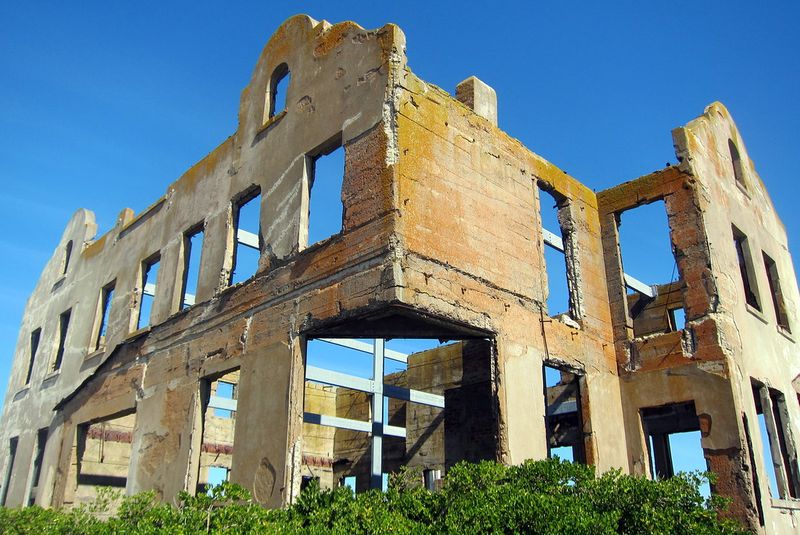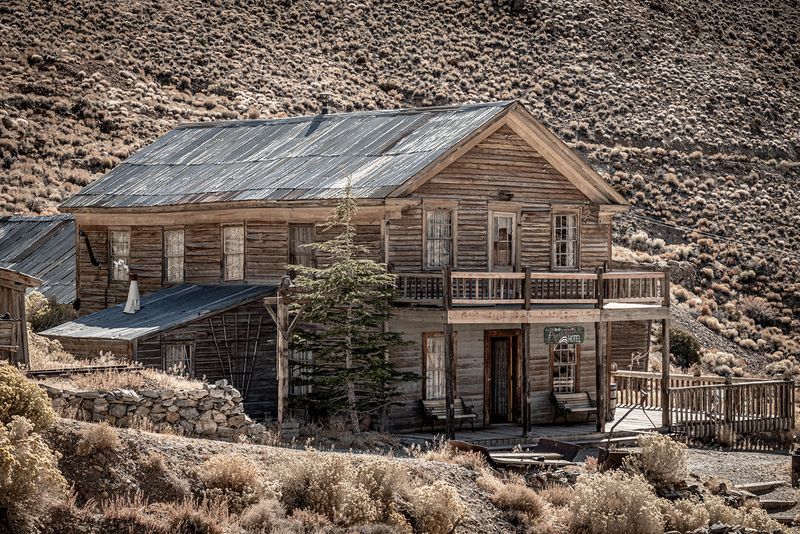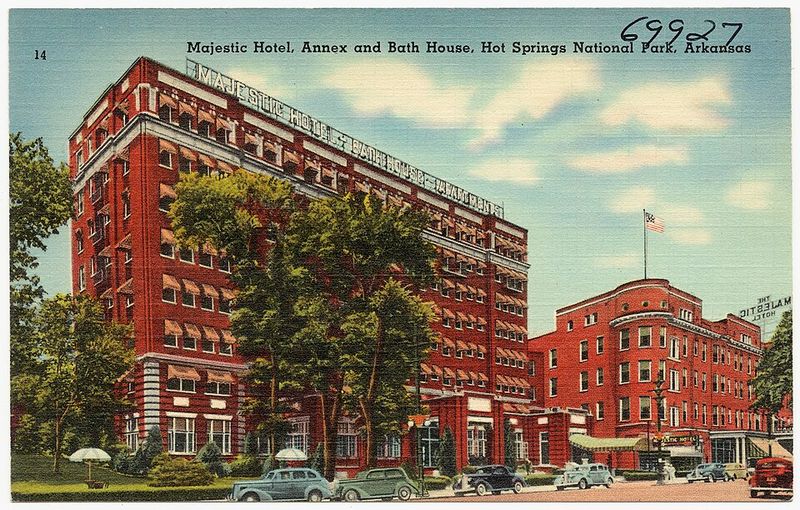America’s landscape is dotted with forgotten places that once buzzed with vacationers, families, and adventure-seekers. From water parks in the desert to grand mountain resorts, these destinations thrived for decades before closing their doors forever. Today, they stand silent—overtaken by rust, weeds, and memories—reminding us how quickly the world can move on from yesterday’s favorite getaways.
Lake Dolores Waterpark (Newberry Springs, California)
Picture a splash-filled oasis in the middle of nowhere—that was Lake Dolores. Marketed as “The Fun Spot of the Desert!” when it opened in the early 1960s, this quirky waterpark drew crowds eager to cool off in the scorching Mojave heat. Families splashed down colorful slides and lounged by pools, making memories under the blazing sun.
By the 1970s and 80s, the park hit its peak popularity. But as highways changed and vacationers found newer attractions closer to home, visitors dwindled. Competition from bigger, flashier parks didn’t help either.
The park finally closed for good in 2004. Today, rust-covered slides twist through weeds, empty pools crack in the desert heat, and a lonely “for sale” sign greets curious explorers. Lake Dolores shows how isolation and shifting trends can turn yesterday’s fun spot into tomorrow’s ghost town.
Penn Hills Resort (Analomink, Pennsylvania – Pocono Mountains)
Romance once bloomed at Penn Hills Resort, a flamboyant honeymoon hideaway nestled in Pennsylvania’s Pocono Mountains. Opening its doors in the 1960s, this resort promised newlyweds everything: heart-shaped tubs, private villas, ski slopes, golf courses, and nightlife that sparkled till dawn. Couples flocked here for decades, making it the ultimate love nest.
But by the late 2000s, tastes had changed. Younger couples wanted tropical beaches or European cities instead of mountain chalets. Economic troubles hit the region hard, and in 2009, Penn Hills closed permanently.
Arson and vandalism followed, destroying many buildings. What’s left now is a haunting skeleton of its former self—broken windows, collapsed roofs, and those famous heart-shaped tubs sitting empty and forgotten. Penn Hills reminds us that even the most romantic places can’t escape time’s harsh reality.
Chippewa Lake Park (Ohio)
Founded way back in 1878, Chippewa Lake Park became a beloved local escape for generations of Ohio families. The park grew over the years, adding roller coasters, a towering Ferris wheel, a bandstand for live music, and all the classic carnival games kids loved. Summer weekends meant cotton candy, screams of joy, and the smell of popcorn drifting through the air.
Competition from bigger theme parks and changing entertainment habits took their toll. By 1978, attendance had dropped so low the owners had no choice but to close the gates forever.
For decades afterward, the rides just sat there—frozen in time. Trees grew through roller coaster tracks, rust claimed the metal, and nature slowly swallowed what humans left behind. Chippewa Lake Park stands as a haunting example of how local treasures can fade when the world moves on.
Williams Grove Amusement Park (Pennsylvania)
Williams Grove has roots stretching back to 1850, making it one of America’s oldest entertainment venues. What started as simple picnic grounds for church gatherings and community events eventually grew into a full-scale amusement park. Families came for the rides, games, and that old-fashioned carnival atmosphere that felt like stepping back in time.
Operating a historic park isn’t cheap, though. Maintaining aging rides, meeting modern safety standards, and competing with flashy new attractions proved too expensive. The park struggled financially for years before finally closing in 2005.
Today, Williams Grove sits silent and crumbling. Its closure highlights a tough reality: nostalgia alone can’t pay the bills. When infrastructure costs outweigh visitor numbers, even beloved historic sites can’t survive. The abandoned park serves as a reminder that keeping history alive sometimes costs more than communities can afford.
Ghost Town Village (formerly Ghost Town in the Sky, Maggie Valley, North Carolina)
Perched dramatically atop Buck Mountain, Ghost Town in the Sky opened in 1961 as a Wild West wonderland with a view. Visitors rode an incline railway or chairlift up the mountain, arriving at a frontier town complete with roller coasters, theatrical gunfights, saloons, and breathtaking scenery. At its peak, half a million people visited annually.
But altitude came with altitude-sized problems. Getting equipment and supplies up the mountain was expensive. Maintaining rides in harsh mountain weather drained budgets. Mismanagement and changing tourism trends didn’t help either.
The park limped through the 2000s before closing for good. Now it’s a literal ghost town—rides rusted solid, buildings boarded up, and weeds pushing through cracked pavement. Ghost Town in the Sky shows how ambitious location choices can backfire when logistics and costs spiral out of control. Sometimes being on top of the world isn’t worth the climb.
Six Flags New Orleans (Louisiana)
Hurricane Katrina didn’t just devastate homes in 2005—it drowned an entire amusement park. Six Flags New Orleans sat in the storm’s path and took a direct hit. Floodwaters submerged rides, destroyed electrical systems, and left behind toxic sludge and destruction. The park never recovered.
In the years since, Six Flags New Orleans has remained frozen in that catastrophic moment. Roller coasters rust in place, bumper cars sit in stagnant water, and graffiti covers every surface. Occasionally film crews use it for post-apocalyptic movie scenes, which feels eerily appropriate.
Insurance disputes, flood risk concerns, and economic challenges made rebuilding impossible. The city had bigger priorities than a theme park. Six Flags New Orleans stands as a haunting monument to nature’s power and the hard choices communities face after disaster. Sometimes, starting over means leaving the past behind—even when it hurts.
St. Thomas, Nevada
Imagine a town that drowned, then rose from the dead decades later. That’s St. Thomas, Nevada. Founded in 1865, this small community thrived until the 1930s when the Hoover Dam project flooded the valley. In 1938, Lake Mead’s rising waters swallowed St. Thomas completely, forcing everyone to leave.
For decades, the town lay hidden underwater. But as droughts lowered Lake Mead’s water levels in recent years, St. Thomas began reappearing like a soggy ghost. Foundations, walls, and remnants of streets emerged from the mud.
Today, it’s become an accidental tourist attraction—people visit to see the eerie ruins and take photos of this drowned town. St. Thomas proves how environmental engineering and water policy can accidentally create ghost towns. It’s also a stark reminder that climate change and resource management have real, visible consequences on the landscape.
Booger Hollow Trading Post (Arkansas)
Roadside America was once full of weird, wonderful stops designed to make travelers hit the brakes. Booger Hollow Trading Post was one of the quirkiest. With its hillbilly theme, novelty outhouse photo ops, and souvenir shop selling kitschy trinkets, it became a must-see oddity for families driving through Arkansas.
The charm was pure Americana—silly, fun, and totally unique. Tourists loved the goofy props and the chance to buy something ridiculous to remember their trip. But when the original owner sold the property in 2004, the new owners never reopened it.
Now, Booger Hollow sits empty and decaying. Nature reclaims the buildings, signs fade, and the novelty that once drew crowds feels outdated. It’s a perfect example of how roadside attractions depend on constant upkeep and fresh appeal. When the novelty wears off and maintenance costs pile up, even the most charming oddities can vanish.
North Field (Tinian, Northern Mariana Islands)
North Field holds a heavy place in history. Built by the United States in 1944 during World War II, this massive airfield launched the planes that dropped atomic bombs on Japan. After the war ended, the military no longer needed it, and North Field was abandoned.
Over the decades, the jungle slowly reclaimed the runways. Vines crawled over concrete, trees pushed through cracks, and nature erased much of what humans built. Yet the site drew visitors—history buffs, veterans, and tourists curious about this pivotal location.
Today, it’s a strange mix of historical significance and tropical decay. You can still see remnants of runways and structures, but they’re surrounded by thick vegetation. North Field reminds us that even places tied to world-changing events can become ghost spaces when their purpose ends. History doesn’t always preserve itself—sometimes it just fades quietly into the jungle.
Centralia (Pennsylvania)
Centralia wasn’t abandoned because people lost interest—it was abandoned because the ground beneath it literally caught fire. In 1962, a coal mine fire ignited underground, and despite efforts to extinguish it, the blaze spread. Smoke seeped through cracks, sinkholes opened, and toxic gases made living there dangerous.
By the 1980s, most residents had evacuated. The government condemned properties and demolished homes. Today, only a handful of people remain in what was once a thriving mining town. Cracked roads with smoke rising through them have become an eerie tourist draw.
Visitors come to see the famous graffiti-covered highway and feel the warm ground beneath their feet. Centralia shows how industrial accidents can turn communities into ghost towns. It’s also a morbid reminder that some disasters never truly end—that fire still burns today, more than sixty years later, with no end in sight.
Alcatraz Island (California)
Wait—isn’t Alcatraz still a tourist hotspot? Yes, but here’s the twist: while thousands tour the famous cell blocks daily, much of the island remains abandoned and decaying. The prison closed in 1963, and many buildings have been left untouched since then.
Wander beyond the main tourist paths, and you’ll find crumbling wards, rusted equipment, and empty rooms slowly falling apart. Salt air and weather have eaten away at structures, creating a haunting contrast between the preserved areas and the forgotten ones. It’s abandonment hiding in plain sight.
Alcatraz offers a unique perspective—it’s both a thriving attraction and a genuine ghost site. The island shows how selective preservation works. We save what draws crowds and ignore the rest. Those abandoned corners remind visitors that even famous places have forgotten spaces where time stands still and decay marches on, unseen by most.
Cerro Gordo Mines (California)
High in California’s Inyo Mountains sits Cerro Gordo, a ghost town born from silver and lead mining booms in the 1860s. At its peak, the town was wild and wealthy—miners, saloons, and fortune-seekers filled the streets. Tourists even visited during the boom years, curious about the rough-and-tumble mining life.
But like all boom towns, Cerro Gordo couldn’t last forever. When the mines played out and metal prices dropped, people left. Buildings emptied, tunnels went dark, and the town became a relic. Today, old structures still stand, and a few tunnels remain accessible.
Recently, new owners purchased Cerro Gordo with hopes of restoration and tourism. Still, much of it remains abandoned—a frozen snapshot of the Old West. Cerro Gordo illustrates how economy-driven towns can collapse overnight when resources run dry. Tourism can follow mining booms, but when the boom goes bust, so does everything else.
The Majestic Hotel (Hot Springs, Arkansas)
Hot Springs, Arkansas, was once America’s spa capital—people traveled from across the country to soak in the natural thermal waters believed to cure ailments. Grand hotels like The Majestic rose to serve this flood of health-seekers and vacationers. With its elegant architecture and luxurious rooms, The Majestic embodied the golden age of spa tourism.
But as medical science advanced and spa culture faded, fewer visitors came. Hotels that once thrived found themselves struggling to fill rooms. The Majestic eventually closed, joining a growing list of abandoned resorts in the area.
Today, the building stands as a derelict monument to a bygone era. While Hot Springs still attracts some tourists, The Majestic remains boarded up and forgotten. It’s a reminder that even destinations with natural advantages can lose their appeal when cultural trends shift. Yesterday’s miracle cure becomes today’s outdated relic, and grand hotels become grand ghosts.
